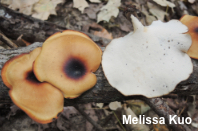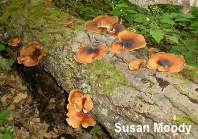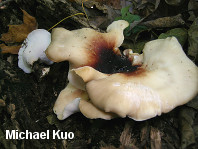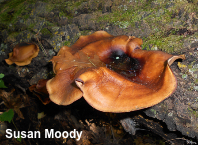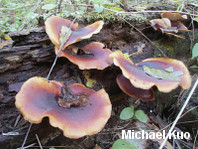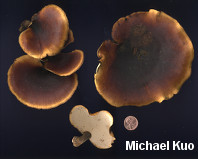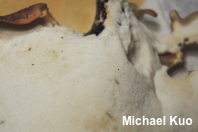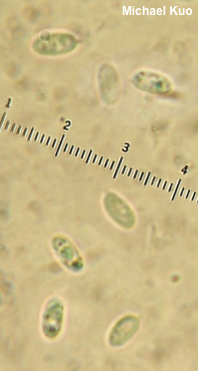| Major Groups > Polypores > Stemmed, Pale-Fleshed > Polyporus badius |

|
Polyporus badius [ Basidiomycota > Polyporales > Polyporaceae > Polyporus . . . ] by Michael Kuo This distinctive polypore can be found on decaying hardwood logs across the continent, helping to decompose the wood. It is fond of colder temperatures, and usually appears in spring and fall in temperate regions; in warmer climates it is often a winter fungus. Polyporus badius features a fuzzy, black stem; a very shallow, white pore surface with extremely tiny (often invisible to the naked eye) pores; and a fairly large cap that can measure up to 20 cm across. The color of the cap is variable; it is usually reddish brown, with a darker central area—but collections are often made in which the fresh cap is creamy whitish, with a reddish brown center. The cap also blackens with age, from the center outward, resulting in quite a range of colors for the species. Polyporus varius is smaller, has a pale brown to tan or yellowish cap, and is usually found on smaller hardwood branches and sticks. Polyporus picipes, in the sense of some authors, is a synonym. Royoporus badius and Picipes badius are also synonyms—but recent studies (e.g. Sotome and collaborators 2008) make it clear that the species currently placed in Polyporus are in need of substantial revision and potential rearrangement, and while we await such a treatment I will use the more familiar name. Thanks to Sue Moody for documenting, collecting, and preserving Polyporus badius for study; her collection is deposited in The Herbarium of Michael Kuo. Description: Ecology: Saprobic on the deadwood of hardwoods (also occasionally reported on the wood of conifers); usually appearing after the bark has begun to decay, or when it is entirely gone; causing a white rot; growing alone or gregariously; spring and Cap: 4–20 or more cm; broadly convex to shallowly depressed; round, kidney-shaped, or lobed in outline; dry; bald; usually dark reddish brown to dark brown, but paler towards the margin—but sometimes pale (nearly white) overall, with a reddish brown center area; blackening slowly from the center outward with old age; often appearing a little streaked. Pore Surface: Running down the stem; white, becoming dingy whitish to brownish in age; not bruising where damaged; pores at first appearing "stuffed," later circular and very tiny (4–6 per mm; often invisible without a hand lens); tube layer 0.5–1 mm deep, not easily separable from cap. Stem: Central or off-center to lateral; 1–4 cm long; 0.5–2 cm wide; equal, or tapered to base; dry; pale at the apex but dark brown to black and velvety elsewhere; tough. Flesh: White; unchanging when sliced; thin; very tough. Odor and Taste: Odor not distinctive. Taste slightly mealy, or not distinctive. Chemical Reactions: KOH negative on cap surface, or grayish on darker, redder caps; negative on flesh. Spore Print: White; often very difficult to obtain. Microscopic Features: Spores 6–8 x 3–3.5 µm; subcylindric; smooth; hyaline in KOH. Hymenial cystidia not found. Hyphal system dimitic: generative hyphae 2–4 µm wide, thin-walled, smooth, septate, hyaline in KOH; skeletal hyphae 2–6 µm wide, walls 0.5–1 µm thick, aseptate; hyaline in KOH. Clamp connections not found. REFERENCES: (Persoon, 1801) Schweinitz, 1832. (Overholts, 1953; Phillips, 1981; Smith, Smith & Weber, 1981; Arora, 1986; Breitenbach & Kränzlin, 1986; Gilbertson & Ryvarden, 1987; Larsen, 1990; Lincoff, 1992; Nunez & Ryvarden, 1995; De, 1997; Barron, 1999; Roody, 2003; Krüger et al., 2006; McNeil, 2006; Miller & Miller, 2006; Binion et al., 2008; Sotome et al., 2008; Buczacki et al., 2012; Dai et al., 2014; Kuo & Methven, 2014; Desjardin, Wood & Stevens, 2015; Siegel & Schwarz, 2016; Baroni, 2017; Ginns, 2017; Gminder & Böhning, 2017; Sturgeon, 2018; Læssøe & Petersen, 2019; McKnight et al., 2021.) Herb. Kuo 04309505, 09270302, 10290703, 05171103, 09211506, 08102002. This site contains no information about the edibility or toxicity of mushrooms. |
© MushroomExpert.Com |
|
Cite this page as: Kuo, M. (2021, April). Polyporus badius. Retrieved from the MushroomExpert.Com Web site: http://www.mushroomexpert.com/polyporus_badius.html |
